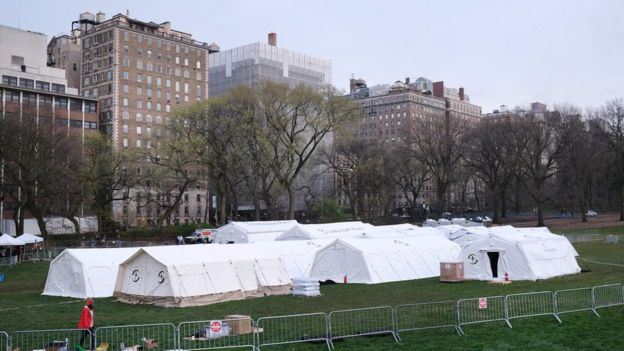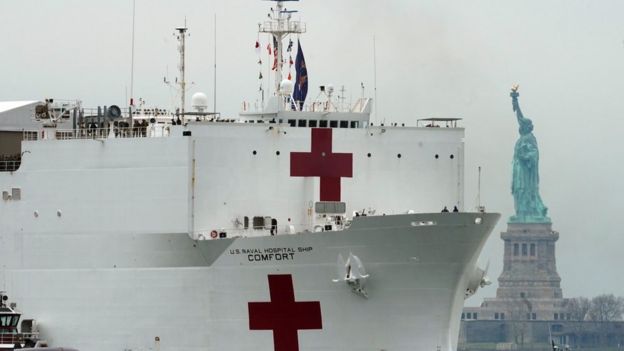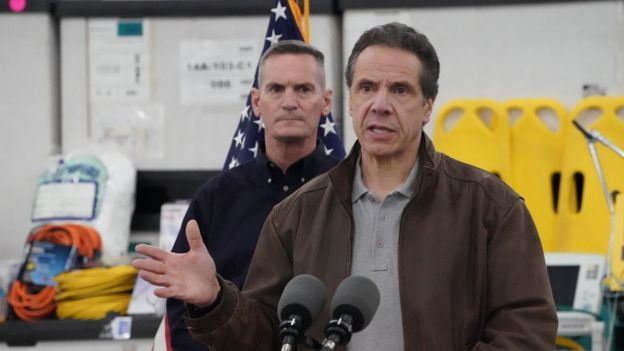Philip Tassi warns that the cemetery where he works is overflowing with orders, but here there is no time for pauses: the government of New York has just announced that between Monday and Tuesday a new record of 731 deaths from the coronavirus was registered in the state.
“The number of burial and cremation requests we have is probably going up 300%,” says Tassi of the Ferncliff graveyard in Westchester, a few miles north of Manhattan.
Up to 20 bodies now pass through that crematorium in 16-hour workdays, seven days a week. But even so, operating at maximum capacity, the schedule is full until the end of next week.
History repeats itself in other places in New York, the epicenter of the coronavirus pandemic in the United States, the country with the most confirmed cases of covid-19 in the world.
“Most cemeteries don’t have refrigeration units for a pandemic. So the biggest problem now is that we don’t have refrigerated storage to keep bodies here for long periods.”
This is stated by Tassi, who chairs the New York State Cemetery Association and has worked in the sector for 23 years.
Funeral homes are also overrun, and the authorities have sent dozens of mobile morgues or refrigerated trailers to hospitals and other parts of the city to prevent corpses from accumulating without a place to receive them, as has happened in other countries hit by the virus.
“I have never seen something like this in my whole life, this number of people who can die in such a short period,” Tassi tells BBC Mundo. “Not even in 9/11 did we have the number of bodies you have with this,” he says, referring to the 2001 attacks in the city.
In fact, those attacks that the US considers the “largest terrorist attack” in its history killed 2,753 people in New York.
But that deadly toll was officially surpassed this week by the coronavirus, which has claimed more than 3,200 lives in the city and 5,489 across the state.
The virus and the city
The pandemic has transformed New York: never has the city been so still and quiet for so long, to the point that you can cross its avenues without waiting for the traffic light to turn green or hear a coin fall on the deserted sidewalk.
The silence is hardly broken when an ambulance passes by with the siren on.
Or at 7:00 p.m. each day, when New Yorkers cheer from their windows to health workers fighting the virus and the city seems to regain its bustling spirit for a couple of minutes.

Local authorities extended until April 29 at least the closure of schools and non-essential businesses, as well as the prohibition of meetings, with fines of up to US $ 1,000 planned for violators.
Although the police do not ostensibly control the movement of people, the 8.6 million New Yorkers have largely complied with the request that they remain in their homes for as long as they can.
The health emergency is impossible to ignore, even for those who are going to exercise for a while in Central Park.
A field hospital installed there by a humanitarian religious organization receives dozens of COVID-19 patients, and Seeing those white tents on the grass of this rich city can shudder.

They have also begun to convert the Cathedral of Saint John the Divine in Manhattan, considered the largest Gothic church in the world, into a hospital.
And the military has transformed the Javits convention center, on the same island, into another temporary hospital with 2,500 available beds.
The goal is to increase health care capacity, which is to the limit in a state with more than 138,800 confirmed cases of coronavirus and more than 17,400 people hospitalized for the disease.
President Donald Trump also this week authorized a military hospital ship he sent to Manhattan to begin receiving COVID-19 patients.
But, in another sign that the disease is spreading uncontrollably, the US Navy reported Tuesday that a crew member of that ship, the USNS Comfort, is infected with coronavirus and others have been preventively isolated.

Despite New York State’s record of 731 deaths from Monday to Tuesday, Governor Andrew Cuomo said hospitalizations and the transfer of patients to intensive care due to the virus have slowed.
This lights a light of hope.
Cuomo suggested that, thanks to social distancing measures, New York could be reaching a plateau on its hospitalization curve.
However, it is still too early to know what will happen.
“We are still not doing enough to find out how many people are infected,” says Theodora Hatziioannou, associate professor of virology at Rockefeller University in Manhattan.
“So, predicting that the peak is this week, the next or the next is impossible at this time,” Hatziioannou tells BBC Mundo.
“Our lives changed”
Warnings have also emerged that the number of coronavirus deaths in New York it may be higher than the official figure.
Councilman Mark Levine, chairman of the city’s health commission, indicated that deaths in private homes have increased 10-fold compared to normal times, reaching between 200 and 215 per day.
“Sure almost all the increase is people with coronavirus. But not all are counted that way,” he tweeted.

Levine also caused a stupor this week by indicating that “temporary burials” of coronavirus victims would soon begin in New York, although he later clarified that it is a contingency plan to discard if the number of deaths falls enough.
Mayor Bill de Blasio admitted Monday there may be such a plan, but denied that there will be any burials in parks. And his spokesperson said they could instead be held on Hart Island, an island in the Bronx.
The truth is that the virus paints a new bleak landscape in this opulent city, which left the nightmare of September 11 in the past.
“9/11 was a terrorist event and this terrifies us, it consumes us every day, whether we are at work or at home with our families: it seems to talk to us all the time, that we talk about it all the time,” reflects Phil Suarez, a paramedic who assisted in efforts to rescue victims of the 2001 attacks.
Suarez also treated war wounded in Iraq in 2017 and worked in disasters, but assures that the coronavirus has made him “much more cautious” in his work, which increased significantly in New York.
“Before we approached a patient without gloves, glasses or a mask, but now we have to protect ourselves completely,” explains the paramedic to BBC Mundo.
“Our lives,” he says, “probably changed drastically from a month ago.”
–


